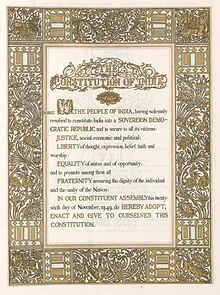| Constitution of India | |
|---|---|
 Original text of the preamble | |
| Overview | |
| Jurisdiction | |
| Ratified | 26 November 1949 |
| Date effective | 26 January 1950 |
| System | Federal parliamentary constitutional republic |
| Government structure | |
| Branches | Three (Executive, Legislature and Judiciary) |
| Head of state | President of India |
| Chambers | Two (Rajya Sabha and Lok Sabha) |
| Executive | Prime Minister of India–led cabinet responsible to the lower house of the parliament |
| Judiciary | Supreme court, high courts and district courts |
| Federalism | Federal[1] |
| Electoral college | Yes, for presidential and vice presidential elections |
| Entrenchments | 2 |
| History | |
| Amendments | 106 |
| Last amended | 28 September 2023 (106th) |
| Citation | Constitution of India (PDF), 9 September 2020, archived from the original (PDF) on 29 September 2020 |
| Location | Samvidhan Sadan, New Delhi, India |
| Signatories | 284 members of the Constituent Assembly |
| Supersedes | Government of India Act 1935 Indian Independence Act 1947 |
| Part of a series on the |
| Constitution of India |
|---|
 |
| Preamble |
The Constitution of India is the supreme legal document of India.[2][3] The document lays down the framework that demarcates fundamental political code, structure, procedures, powers, and duties of government institutions and sets out fundamental rights, directive principles, and the duties of citizens. It is the longest written national constitution in the world.[4][5][6]
It imparts constitutional supremacy (not parliamentary supremacy, since it was created by a constituent assembly rather than Parliament) and was adopted by its people with a declaration in its preamble. Parliament cannot override the constitution.

It was adopted by the Constituent Assembly of India on 26 November 1949 and became effective on 26 January 1950.[7] The constitution replaced the Government of India Act 1935 as the country's fundamental governing document, and the Dominion of India became the Republic of India. To ensure constitutional autochthony, its framers repealed prior acts of the British parliament in Article 395.[8] India celebrates its constitution on 26 January as Republic Day.[9]
The constitution declares India a sovereign, socialist, secular,[10] and democratic republic, assures its citizens justice, equality, and liberty, and endeavours to promote fraternity.[11] The original 1950 constitution is preserved in a nitrogen-filled case at the Old Parliament House in New Delhi.[12]
- ^ Cite error: The named reference
structurewas invoked but never defined (see the help page). - ^ Original edition with original artwork - The Constitution of India. New Delhi: Government of India. 26 November 1949. Archived from the original on 22 March 2019. Retrieved 22 March 2019.
- ^ "Preface, The constitution of India" (PDF). Government of India. Archived (PDF) from the original on 31 March 2015. Retrieved 5 February 2015.
- ^ Cite error: The named reference
:2was invoked but never defined (see the help page). - ^ Pylee, Moolamattom Varkey (1994). India's Constitution (5th rev. and enl. ed.). New Delhi: R. Chand & Company. p. 3. ISBN 978-8121904032. OCLC 35022507.
- ^ Nix, Elizabeth (9 August 2016). "Which country has the world's shortest written constitution?". History. A&E Networks. Archived from the original on 24 July 2018. Retrieved 24 July 2018.
- ^ "Introduction to Constitution of India". Ministry of Law and Justice of India. 29 July 2008. Archived from the original on 22 October 2014. Retrieved 14 October 2008.
- ^ Swaminathan, Shivprasad (26 January 2013). "India's benign constitutional revolution". The Hindu: Opinion. Archived from the original on 1 March 2013. Retrieved 18 February 2013.
- ^ Das, Hari (2002). Political System of India (Reprint ed.). New Delhi: Anmol Publications. p. 120. ISBN 978-8174884961.
- ^ "Aruna Roy & Ors. v. Union of India & Ors" (PDF). Supreme Court of India. 12 September 2002. p. 18/30. Archived (PDF) from the original on 7 May 2016. Retrieved 11 November 2015.
- ^ "Preamble of the Constitution of India" (PDF). Ministry of Law & Justice. Archived from the original (PDF) on 9 October 2017. Retrieved 29 March 2012.
- ^ Malhotra, G. C. (September 2000). "The Parliament Estate" (PDF). The Journal of Parliamentary Information. XLVI (3): 406. Archived (PDF) from the original on 3 October 2022. Retrieved 17 October 2022.